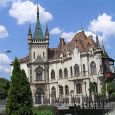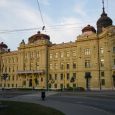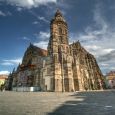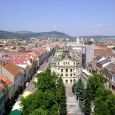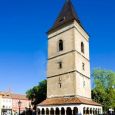Kosice
Advertisement
By plane
You can fly to Košice from Bratislava, Vienna or Prague. Currently, no low-cost airlines are serving Košice.
By train
Prague: 8h, EC Kosican; 9½h, 3 night trains a day
Moreover there are many daytime connections with change at Zilina.
Bratislava:
6h, fast train every 2 hours; 5h, 3 IC trains a day; 7h, night train Poľana
By bus
Given the efficiency and value of the train system, you shouldn't need to use the bus system very much. Eurolines coaches come to here from numerous European cities, and bus is the the most efficient way of reaching the nearby town of Levoca.
Palaces of Kosice
KoSice is the city which has the highest number of palaces in Slovakia and all of them are worth seeing. Perhaps the most important palace is the Former Town Hall, which is the oldest of Košice's council offices. The Andrassy's Palace today serves as the biggest cafeteria and patisserie - AIDA. The other palaces include The Bishop's Palace , Hadik - Barkoczy Palace , PongrAcz - Forgács' Palace - the seat of the Regional State Library and Csáky - Dessewffy Palace - at present the building is the seat of the Constitutional Court of Slovak Republic and at the same time it is the so-called 'palace of the books' as you can find the biggest bookstore of Košice, selling books not only in Slovak, but also in Hungarian, English, German and other languages. We shall not to forget about the Captain's Palace where you can find the Slovak Technical museum and last but not least, Jacab's Palace which was erected in 1899 in the pseudo-Gothic style constructed from discarded stones from the Kosice St. Elizabeth's Cathedral and most of the inhabitants of Košice would choose this building as one of the most beautiful ones.
The Main Street (Hlavna ulica)
The Main street of Košice is the biggest historical are in Slovakia, where most of the sights worth seeing are located. With its unique atmosphere it creates the heart of the town. In the past, it used to be a medieval square and the whole town started to grow from this point. Now this place is flat, however in the past it used to be hilly and even a stream flew there. The "Čermeľský potok" (The Tshermel stream) used to create an island on the main street, where the Saint Elizabeth cathedral is located now. Due to developing infrastructure, this stream has been landed up in 1899 and was renewed only symbolically during the renovation of the main street in the 1990's. Today, all the traffic from the main street is excluded, therefore it is a very pleasant pedestrian site. Except the Saint Elizabeth Cathedral, you will find also the Saint Michael Chapel, Urban tower, The State Theater, the so-called singing fountain (a unique fountain in Europe), as well as many stylish original bourgeois houses
Saint Elizabeth's Cathedral
This remarkable medieval monument was built in the High Gothic style. The present cathedral stands on a site formerly occupied by a parish church, which was destroyed by fire around year 1370. The patrons of the church included St. Elizabeth. The construction of St. Elizabeth's Cathedral began approximately in 1378. The entrance to the cathedral is for free anytime during the day. There is also a possibility to visit the northern tower of the cathedral, which gives you a stunning view of the surrounding historical centre. The height of this tower is 59.7m and contains 160 stairs in the staircase. It is open all year long between 10am and 17pm. You can buy the tickets at the entrance to the cathedral. The entrance fee is rather cheap.
St. Michael's Chapel
The chapel probably comes from the first half of the14th century and had always been a part of the parish church. It was built as a cemetery chapel in the centre of a cemetery inside the city walls stretching from the Cathedral to the South on the island of the Čermeľský potok (Čermeľ brook) in the place of the present park in the Hlavná ulica (Main street). The outer decoration is Gothic, the turret is fitted in the roof structure. The patron of the dead, the Archangel Michael, vanquishing the Satan as dragon is shown on the altar. There are Archangels Rafael and Gabriel on his sides. In the interior, there is a nice stone tabernacle, the ornamental sculpture "Ecce Homo" and remainings of wall paintings from Middle Ages. The oldest coat-of-arms of Košice is situated above the door leading to the vestry.
Beggar's House
For an interesting story you may look up the Beggar's House which is one of the historical houses on Hlavna (on the right between the Theater and Immaculata when walking up north). On forefront, at top of the house you will see a statue of a guy with a hat thanking/begging for alms. The story says the career beggar who had no other income had over years used generosity of rich Košice dwellers to build the house at what was then a very 'high-end' medieval (a.k.a. Hlavna Street) part of Košice. This kind of largess may seem to be perceived a bit strange by today's beggars rarely appreciating Košice inhabitants, but it still makes up for a good narrative. And a historic house.
East Slovak Museum
East Slovak Museum was established in 1872 and it is one of the oldest and most significant museums in Slovakia. From the architectonic point of view, the buildings of the museum itself are very interesting historical sights. In this museum, the following permanent expositions can be found: the nature of Carpathia, Hundreds of years of art, "Rodosto" - the memorial house of Franz II. Rakoczy, Artistic metal founding in Eastern Slovakia and Centuries of Košice - Mikluš's Prison. Except these expositions, there are always some temporary events and expositions.
Saint Urban's tower
Originally a Gothic prismatic campanile with a pyramidal roof dating back to the turn of the 14th and 15th centuries. The bell, which was installed in the tower (its weight equals to 7 tones), was dedicated to St. Urban, the patron of wine-prowers, which was cast in a mould by the bell founder Frantisek Illenfeld of Olomouc in 1557. 36 tombstones dating from the 14th century (one of these tombstones is Roman dating from the 4th century) to the 17th century were put into the outer walls of the Tower. In 1966 the Tower was damaged by fire, which destroyed the roofing and the bells. In the years 1967-1971 the Tower was subjected to restoration and renovation.
Information not available


